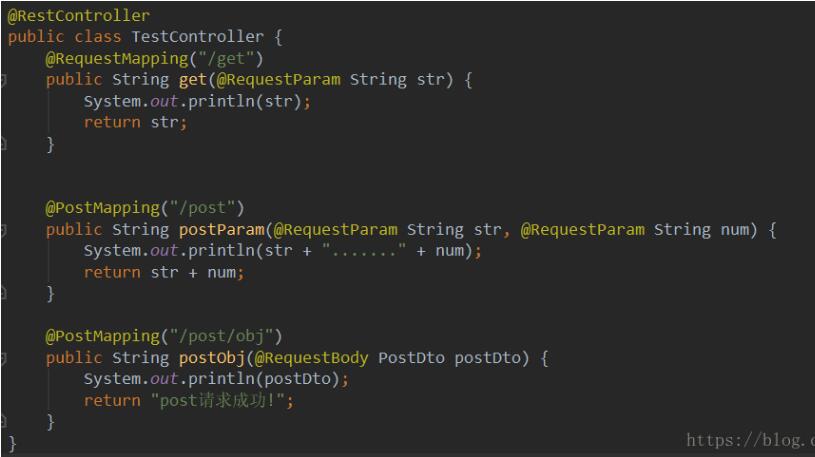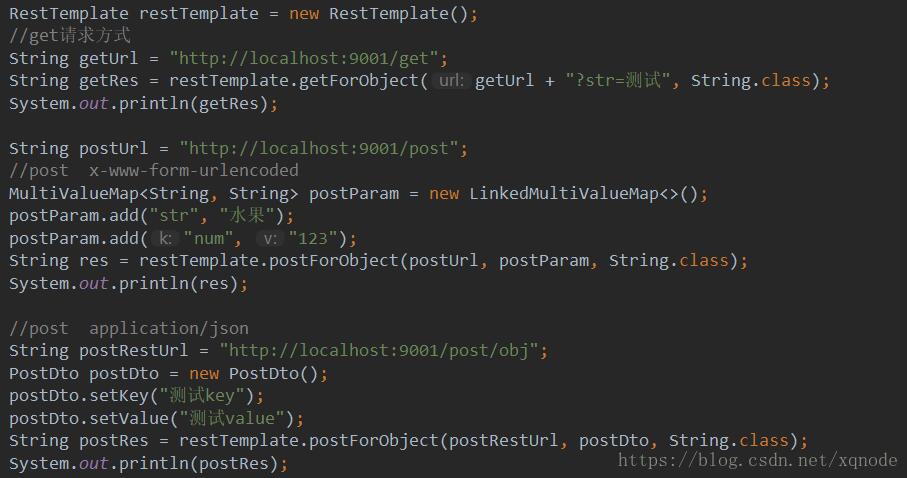下图是我的所有测试接口,包含两个表单提交接口和一个Rest接口:

我是用的Http请求工具是Spring自带的RestTemplate。
请求的方法如下:

三个请求分别对应三个接口,在此记录下。
下载文件,获取文件字节流:
RestTemplate restTemplate = new RestTemplate();
HttpHeaders headers = new HttpHeaders();
ResponseEntity<byte[]> entity = restTemplate.exchange("http://ip:port/test.doc", HttpMethod.GET,new HttpEntity<>(headers), byte[].class);
byte[] body = entity.getBody();
multipart/form-data 文件上传:
RestTemplate restTemplate = new RestTemplate();
String url = "http://127.0.0.1:8080/file/upload"
MultiValueMap<String, Object> multiValueMap = new LinkedMultiValueMap<>();
// 设置multi/form-data文件
multiValueMap.add("file", new FileSystemResource("D:/1.mp3"));
multiValueMap.add("name", "测试材料");
// http请求
String response = restTemplate.postForObject(url, multiValueMap, String.class);
补充知识:restTemplate发送get与post请求 并且带参数
我就废话不多说了,大家还是直接看代码吧~
@Test
public void test() throws Exception{
String url = "http://localhost:8081/aa";
//headers
HttpHeaders requestHeaders = new HttpHeaders();
requestHeaders.add("api-version", "1.0");
//body
MultiValueMap<String, String> requestBody = new LinkedMultiValueMap<>();
requestBody.add("id", "1");
//HttpEntity
HttpEntity<MultiValueMap> requestEntity = new HttpEntity<MultiValueMap>(requestBody, requestHeaders);
//post
ResponseEntity<String> responseEntity = restTemplate.postForEntity(url, requestEntity, String.class);
System.out.println(responseEntity.getBody());
ResponseEntity<String> responseEntity1 = restTemplate.exchange("http://172.26.186.206:8080/hive/list/schemas?appid=admin_test",
HttpMethod.GET, requestEntity, String.class);
System.out.println(responseEntity1.getBody());
}
restTemplate的注解如下:
@Component
public class MyConfig {
@Autowired
RestTemplateBuilder builder;
@Bean
public RestTemplate restTemplate() {
return builder.build();
}
}
发送get请求
@Test
public void testCheck() {
String url = "http://172.26.186.206:8080/syncsql/process";
String timeStramp = String.valueOf(System.currentTimeMillis());
HttpHeaders headers = new HttpHeaders();
headers.add("appid", "");
headers.add("sign", sign(null, null,null));
headers.add("timestamp", timeStramp);
JSONObject jsonObj = new JSONObject();
HttpEntity<String> formEntity = new HttpEntity<String>(null, headers);
Map<String, Object> maps = new HashMap<String, Object>();
maps.put("sql", "select * from jingfen.d_user_city");
maps.put("type", 1);
maps.put("account", "admin_test");
ResponseEntity<String> exchange = restTemplate.exchange(url + "?sql={sql}&type={type}&account={account}",
HttpMethod.GET,
formEntity, String.class, maps);
String body = exchange.getBody();
LOGGER.info("{}", body);
}
以上这篇RestTemplate发送get和post请求,下载文件的实例就是小编分享给大家的全部内容了,希望能给大家一个参考,也希望大家多多支持自学编程网。

- 本文固定链接: https://zxbcw.cn/post/196760/
- 转载请注明:必须在正文中标注并保留原文链接
- QQ群: PHP高手阵营官方总群(344148542)
- QQ群: Yii2.0开发(304864863)
